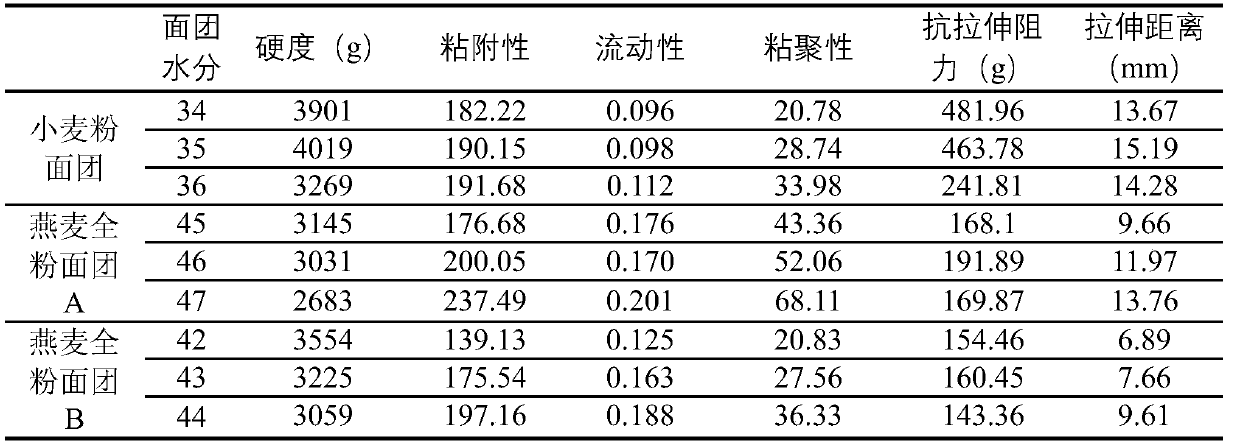A whole oatmeal hypolipidemic functional semi-dry noodle and production method thereof
A semi-dry noodle and blood lipid-lowering technology, which is applied to the functions of food ingredients, food ingredients containing inorganic compounds, food science, etc., can solve the problems of high broken rate of noodle products, high activity of lipoxygenase, weak gluten structure and no stickiness Improve the processing quality and eating quality, increase the digestion and absorption rate, and ensure the storage stability
- Summary
- Abstract
- Description
- Claims
- Application Information
AI Technical Summary
Problems solved by technology
Method used
Image
Examples
Embodiment 1
[0066] Embodiment 1, the making of whole oats hypolipidemic functional semi-dry noodles
[0067] (1) Preparation of pretreated whole oat flour
[0068] 1) Raw material cleaning
[0069] The oats are detrammied, hulled, milled and screened by conventional means.
[0070] 2) Stone milling
[0071] The cleaned oat grains are put into a stone mill for grinding to obtain 80-mesh oat whole powder.
[0072] 3) Stabilization treatment
[0073] The whole oat powder was placed in a microwave stabilization device, and the treatment time was 6 minutes at a temperature of 70°C.
[0074] 4) extrusion puffing
[0075] The stabilized whole oat flour is put into extrusion equipment, the moisture content of the material is 13%, the extrusion temperature is 120° C., and the screw speed is 150 r / min to obtain mature oat flour.
[0076] 5) Superfine grinding
[0077] The whole oat powder was ultrafinely pulverized, and put into a ball mill by means of a grinding medium pulverization method,...
Embodiment 2
[0093] Example 2, the production of whole oatmeal hypolipidemic functional semi-dry noodles
[0094] (1) Preparation of pretreated whole oat flour
[0095] 1) Raw material cleaning
[0096] The oats are removed, shelled and screened by conventional methods.
[0097] 2) Hammer mill
[0098] The cleaned oat grains are put into a hammer mill for pulverization to obtain 250-mesh oat whole powder.
[0099] 3) Stabilization treatment
[0100] Open the whole oatmeal powder and spread it into a thin layer of 0.5cm in a metal container, steam it with atmospheric pressure steam at 105°C for 15min, and then perform degreasing treatment.
[0101] 4) Frying treatment
[0102] The final oat bran powder and oat heart powder are mixed, subjected to frying treatment, and fully stir-fried at a temperature of 70-120° C. to obtain mature whole oat flour.
[0103] 5) Superfine grinding
[0104] The whole oat powder was ultrafinely pulverized by airflow ultrafine pulverization method, put into...
Embodiment 3
[0113] Example 3, Production of whole oatmeal hypolipidemic functional semi-dry noodles
[0114] (1) Preparation of pretreated whole oat flour
[0115] 1) Raw material cleaning
[0116] The oats are removed, shelled and screened by conventional methods.
[0117] 2) Grinding
[0118] Put the cleaned oat grains into an ordinary mill for pulverization to obtain 100-mesh oat whole powder.
[0119] 3) Stabilization treatment
[0120] Place the oat flour in a hot air oven, bake at 155°C for 30 minutes, and then perform degreasing treatment.
[0121] 4) Tumble dry treatment
[0122] Mix oat whole powder with water at a material-to-liquid ratio of 1:4, and distribute the slurry evenly on the surface of a steam-heated drum at a temperature of 150°C to obtain pre-cooked oat whole powder.
[0123] 5) Superfine grinding
[0124] The whole oat powder was ultrafinely pulverized by mechanical shear ultrafine pulverization, put into a mechanical ultrafine pulverizer, and pulverized for...
PUM
 Login to View More
Login to View More Abstract
Description
Claims
Application Information
 Login to View More
Login to View More - R&D
- Intellectual Property
- Life Sciences
- Materials
- Tech Scout
- Unparalleled Data Quality
- Higher Quality Content
- 60% Fewer Hallucinations
Browse by: Latest US Patents, China's latest patents, Technical Efficacy Thesaurus, Application Domain, Technology Topic, Popular Technical Reports.
© 2025 PatSnap. All rights reserved.Legal|Privacy policy|Modern Slavery Act Transparency Statement|Sitemap|About US| Contact US: help@patsnap.com



